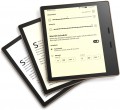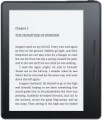Screen
— Display size. The diagonal size of the e-reader display in " (1 " is approximately equal to 2.5 cm). The larger the screen, the higher its resolution (see Display Resolution) and the more text you can display on it at one time. However, it is worth considering that the size of the screen also directly affects the size of the device itself. There are
books 6 ",
7 ",
10 " and even
13 ".
— Display resolution. The display size of the e-reader in pixels horizontally and vertically. The higher the display resolution (from the popular
800x600,
1024x758,
1200x825) - the clearer, more detailed image it can reproduce; in particular, on higher-resolution displays, letters appear smoother and lines appear smoother overall.
High resolution is especially important for large diagonal displays.
— Execution technology. Electronic book displays are made using paper-like technology (
E Ink,
E Ink Carta,
E Ink Carta Mobius,
E Ink Carta Plus,
E Ink Kaleido and subsequent editions of Kaleido).
— E Ink. Historically the first and most wi
...despread technology today. Each pixel of such a display is an oil-filled bubble containing two groups of pigment particles - black and white. Control electrodes are connected to each bubble at the top and bottom. Particles of different colors have different charges; Thus, by applying certain pulses to the electrodes, it is possible to determine which pigment will be on top and, accordingly, what the visible color of the pixel will be. At the same time, using combinations of white and black pigment in different proportions, you can achieve not only pure white or pure black, but also different gradations of gray. E Ink screens have good reflectivity, but are more expensive.
— E Ink Card. An updated version of the classic E Ink e-paper (see above), introduced in 2013. With the same energy efficiency indicators, it provides significantly higher contrast and reflectivity - in other words, the image on such a screen looks sharper and more pleasing to the eye. In addition, Carta uses optimized refresh technology that smoothes the image when pages are re-rendered and further improves the user experience. With such screens it is possible to use sensors and LED backlights.
- E Ink Carta Mobius. The basis of screens made using E Ink Carta Mobius technology is not the usual glass substrate, but a special flexible plastic. There are already prototypes of electronic readers with folding displays based on this technology, which resemble the format of a classic paper book. In general, Mobius displays turned out to be stronger and more reliable than e-reader screens on glass substrates.
- E Ink Card Plus. An advanced version of E Ink Carta technology with a high pixel density of about 300 ppi. Images and text on such displays are incredibly smooth and detailed, and the number of artifacts when partially redrawing pages is kept to a minimum. E Ink Carta Plus screens often support touch controls and are compatible with LED backlighting systems.
- E Ink Kaleido. Colored digital paper for comfortable reading of illustrated books, textbooks and electronic editions of glossy magazines. Similar reader screens are built on a substrate made of a traditional black-and-white E Ink panel, on top of which an array of color filters is applied. Paper-like displays based on Kaleido technology are capable of displaying 16 levels of gray and 4096 color shades.
- E Ink Kaleido Plus. An improvement on the original Kaleido technology, the Plus version has reduced the distance between the layers of color photo filters and monochrome ink, and also modernized the backlight system. As a result, screens based on this technology produce brighter and more saturated colors. E Ink Kaleido Plus allows you to create color displays with a diagonal of 7.8 " and larger.
— E Ink Kaleido 3. The substrate for such screens was the black-and-white film E Ink Carta (see above), on top of which an array of color photo filters E Ink Print Color ePaper was placed. Optimization of the display structure made it possible to increase color saturation by a good third (compared to Kaleido Plus technology). At the same time, Kaleido's third-generation screens are now equipped with front-lit E Ink ComfortGaze for ease of reading in low-light conditions and even in complete darkness. Readers with similar displays are available in standard sizes of 7.8, 10.3 and 13.3 " diagonally.
— SiPix. A relatively recent technology. In such screens, unlike E Ink, each pixel bubble contains not two types of pigments, but only one - white; The role of the black pigment is played by the liquid filling the bubble. These displays are easier and cheaper to produce than E Ink, but are less reflective and can result in a grayer appearance.
— Color depth. The number of colors displayed by the e-reader screen. For black-and-white screens, color depth is expressed in the number of shades of gray; for color screens, it is expressed in the total number of colors displayed. The larger this number, the more realistic and close to the original the image is displayed. However, we note that in practice, color depth matters only for viewing graphic materials (drawings, comics, web pages, etc.) - for ordinary text, in the vast majority of cases, white and black colors are sufficient.
- Touchscreen. The screen is pressure sensitive and can serve as an additional input device. With such a screen, the reader’s main functions (menu navigation, page turning) can often be used without using any hardware keys at all. And sometimes the touch display even expands the functionality of the device - for example, a keyboard for typing can be displayed on the screen, which is especially important for readers that are not equipped with a hardware QWERTY keyboard (see QWERTY keyboard).
— Protected screen. In the context of electronic “readers”, it is customary to use coatings made of special tempered glass to protect the screen from scratches and mechanical damage. Thus, the most vulnerable part of the e-book receives protection from negative environmental factors. An unobvious advantage of the protected screen is that it gives the device a more modern appearance, because e-readers usually have displays recessed into the case, and with protective glass it will be flush with the entire plane of the front panel.
— Backlight. The e-reader has a display backlight system. This allows you to use the reader in low light conditions or in the dark, but the use of backlight significantly affects battery life (which is especially noticeable in devices based on e-paper). Almost all readers with TFT screens have this function, but it is not always found with paper-like screens - therefore, external lighting systems are specially produced for such books (for example, a case with a built-in light bulb).Button control
The presence of a touch screen allows you to configure and control the device using the display. However, for greater convenience, in many e-readers, regardless of the type of screen, the
buttons still act as the main controls. Firstly, they can be pressed with gloves or wet hands. Secondly, holding a book with two hands is much easier to press the button to turn the page than to swipe your finger across the screen.
RAM
The amount of the reader's own RAM, that is, the memory used for temporary data storage during operation. The speed of the e-book directly depends on the amount of RAM, especially when working with large files. So the average value can be considered
RAM 1 GB and
2 GB, and more advanced models have
3 GB,
4 GB and even
6 GB of memory.
Storage capacity
The amount of the reader's own built-in memory, i.e. the memory used for persistent data storage. The more memory, the more content can be stored at a time in the e-book. At the same time, note that even the largest text (TXT, FB2, HTML) files, usually, rarely exceed 2 – 3 MB, so relatively little memory is needed for storage. Graphic and audio files, in turn, are more voluminous, but most of the space is needed for video files. Therefore, depending on the use of the gadget, you will need a different volume, whether it be
4 GB, 8 GB or more. Many readers support the ability to expand their own memory through removable cards (see
Memory card slot).
Data transfer
—
Wi-Fi. A wireless communication module that allows you to connect the reader to wireless local (home or office) networks, as well as access the Internet through public access points (hot spots) installed in restaurants, hotels, railway stations, etc.
—
Bluetooth. Direct wireless communication technology between various electronic devices. In e-readers, Bluetooth is primarily used for file transfer: with this function, you can connect the reader to another Bluetooth device, such as a laptop or tablet PC, and exchange files with it.
— microUSB. Connector for direct connection of the reader to the USB port of the computer using a special cable. In e-books, this connection is used primarily for file sharing. MicroUSB is a universal standard that allows you to connect various gadgets through it with one cable.
— miniUSB. Similar to the one described above, the connector, which differs only in the size and shape of the connector.
—
USB-C. Symmetrical USB connector, which is gaining popularity and in the future is able to displace microUSB. At the same time, the connector has a high data transfer rate and is only a little larger in size.
Dust-, waterproof
The level of protection of the device electronics. It is determined according to the IP standard and is marked with two numbers: the first indicates dust protection, the second — about water protection.
Dust protection values:
5 — dust resistance without complete closure (a certain amount of dust can get inside, but it is small and does not affect the operation of the device)
6 — full protection (dust is not able to penetrate inside the case).
Waterproof values:
6 — protection against sea waves and strong water jets (some of the water may get inside, but it does not impair performance);
7 — the possibility of short-term immersion under water to a depth of 1 m (protection against falling into puddles and other shallow water bodies);
8 — the possibility of long-term immersion to a depth of 1 m or more (the specific value may vary), as well as long-term work in a submerged position.
Case included
The presence
of a case in the delivery set of the electronic reader.
The case facilitates transportation of the device, protects its body from dirt and scratches, and to some extent protects from impacts and vibrations. The design of such an accessory can be different. One of the popular implementations is the "book" format (the case opens in the image and likeness of a book cover), cases exclusively for the back panel of the e-reader are also often found.

